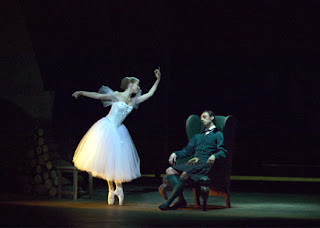The contrast
between what I wrote about in my last blog (Le Coq D’Or) and what I saw this
week could not have been greater. I went
from a piece that was first performed almost 100 years ago to see two new
pieces performed by Dansk Danseteater (DDT).
The evening was
composed of three pieces. The first of
these was “Dilemma of Obedience”, choreographed by Edhem Jesenkovic. Born in Sarajevo, Jesenkovic completed his
dance training in Sweden. He is a former
dancer with DDT, now based at the Carte Blanche company in Norway. The publicity material from DDT states that
he “works in close collaboration with
the dancers, developing choreography with an intricate body language by going
in depth with each individual movement and examining the physical potential of
the body”
The title of the piece comes from
Stanley Milgrams experiment where an anonymous experimenter successfully
ordered adults to subdue a man and submit him to electric shocks. Jesenkovic
states:
‘A substantial proportion of people do what they
are told to do, irrespective of the content of the act and without limitations
of conscience, so long as they perceive that the command comes from a
legitimate authority….. one can only wonder what government, with its vastly
greater authority and prestige, can command of its subjects’.
It was a stark
and moving piece, evoking some of the feelings from an earlier piece I had seen
by him. The dancers began in a single
file column on the right hand side of the stage and slowly progressed across
the stage, and I have to say that this
initial sequence was really interesting to watch and that I was hooked within the
first two minutes. The piece continued
with the appearance at the back of masked figures, standing still, watching the
dancers. These figures then moved into
the body of the piece, providing a foil for the dancers.
It was a really
good start to the evening. The dancers
were in fine form and the greyness of the piece added to its impact and depth.
The two pieces
after the interval were choreographed by Itzik Galili, who has worked with Batsheva Dance
Company and Netherlands Dance Theatre 2.
The first was “Fragile”, a duet that was an exploration of our strengths
and fears. It was a lyrical and powerful
piece, and beautifully danced. The final
piece of the evening was “Peeled”. This
is a dynamic and energetic piece that was danced by the 12 dancers of DDT (it was originally choreographed for 10 dancers). The floor was lit in squares like a chessboard,
with different areas being lit at different times, almost creating a puzzle
like effect. The percussive rhythms,
which formed the background music, added to the speed and dynamism of the
piece.
It was an excellent evening – well done Dansk Danseteater and Tim
Rushton for yet again giving us a good night’s dance.
Check out http://www.danskdanseteater.dk/






